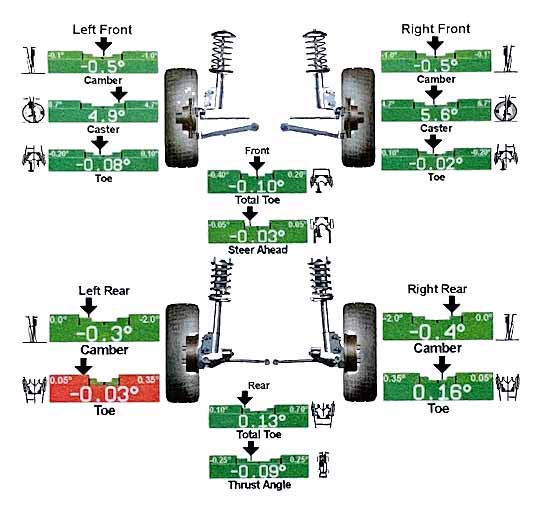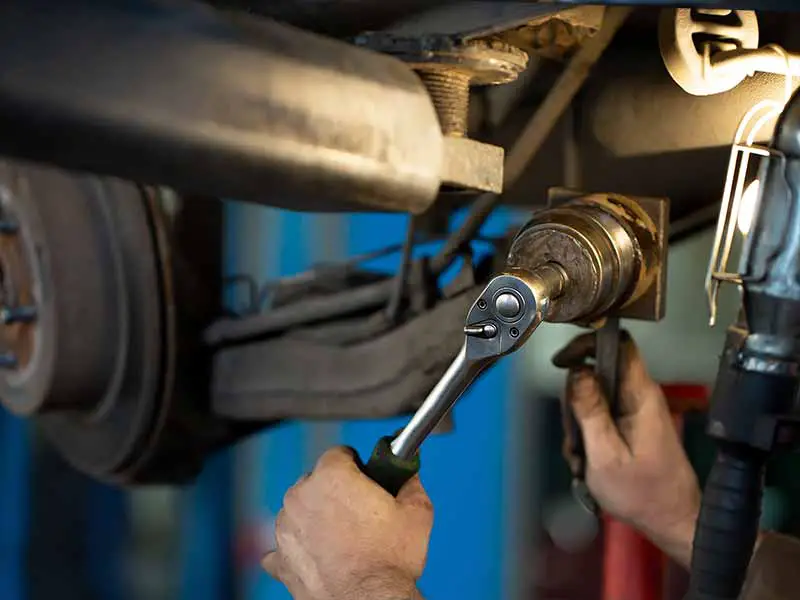No one wants to hear the words: “We can’t do your wheel alignment.” Whether you’ve just bumped into a curb or noticed your tires wearing out unevenly, alignment issues aren’t just a simple fix—it’s about safety, performance, and saving money down the line.
Reasons You Can’t Get An Alignment
You can’t get an alignment primarily due to issues related to your car’s condition, such as structural damages, worn-out suspension parts, or modifications. Additionally, problems with the shop’s equipment or lack of expertise can be contributing factors.
In this article, we delve deep into understanding the basics of wheel alignment, explore the main reasons shops might decline alignment services, identify key suspension components affecting alignment, and discuss the dangers of driving with improper alignment.
Let’s take a closer look.

Understanding Alignment Basics
Wheel alignment, sometimes referred to as “tire alignment,” is the process of adjusting the angles of wheels so they are parallel to each other and perpendicular to the ground. This ensures optimal tire wear, proper handling, and a smooth ride.
Why is Alignment Important?
Proper alignment is essential for several reasons:
- Safety: Misaligned tires can cause your vehicle to steer in unintended directions, making it hard to control.
- Tire Wear: Properly aligned tires wear evenly, extending the life of the tires and saving you money in the long run.
- Fuel Efficiency: A well-aligned car is more aerodynamic, which reduces resistance as you drive, ultimately saving on fuel.
- Comfort: A misaligned vehicle can result in a rougher ride and vibrations in the steering wheel or seat.
Alignment Angles
Alignment typically involves adjustments of three main angles:
- Camber:
- This is the tilt of the tire when viewed from the front of the car.
- If the top of the tire leans outward, it has positive camber; if it leans inward, it has negative camber.
- Toe:
- This refers to whether the fronts of the tires are closer (toe-in) or farther apart (toe-out) than the rears of the tires when viewed from above.
- Caster:
- This is the angle created by the steering’s pivot point from the front to the back of the vehicle.
- Positive caster means the steering axis tilts towards the driver, while negative caster tilts away from the driver.
How Often Should You Check Alignment?
It’s advisable to check your vehicle’s alignment:
- After a Major Impact: Such as hitting a pothole, curb, or undergoing an accident.
- When Purchasing New Tires: Ensuring they’re aligned can prolong the new tires’ lifespan.
- Annually: Even without noticeable signs, it’s a good preventive measure.

Reasons a Shop Might Say They Can’t Do Your Car’s Wheel Alignment
Your Car’s Condition
When the condition of your car causes an alignment shop to decline your money you know you have a real problem. Your car’s alignment may not be able to be properly aligned for a variety of reasons:
Structural Issues
- Accidental Damage: If your car has recently been in an accident, certain structural components might be bent or misshapen.
- Rust and Corrosion: Over time, especially in areas with harsh weather conditions, critical parts of your car can corrode, which might make alignment unsafe or ineffective.
Worn-out Suspension Components
- Bushings or Wheel Bearings: These can wear out over time or due to harsh driving conditions, affecting alignment.
- Control Arms: If bent or damaged, they can prevent accurate wheel alignment.
- Struts and Shocks: If these components are excessively worn or damaged, aligning the wheels can be futile until they’re replaced.
Modifications
- Lifted or Lowered Vehicles: If you’ve made significant changes to your vehicle’s height, standard alignment tools and procedures might not work.
- Aftermarket Parts: Non-standard components can sometimes be incompatible with typical alignment procedures.
Age of the Vehicle
- Obsolete Components: Very old cars may have unique requirements or parts that are no longer readily available. Some shops might not have the tools or expertise for such vehicles.
Damaged or Worn-Out Equipment
A shop’s equipment is as important as a mechanic’s expertise. If their tools aren’t in top condition:
- Inaccurate Readings: Calibration tools or a worn out alignment rack might give false readings, leading to incorrect adjustments.
- Safety Concerns: Using faulty equipment can cause damage to your vehicle or result in an improperly executed alignment.
Lack of Expertise
Every vehicle is unique, and sometimes a shop might not feel confident aligning a particular model:
- Unfamiliar Car Models: New or uncommon vehicles might have specifications unfamiliar to the mechanic.
- Continuous Training: As cars evolve, so do their alignment needs. Not all mechanics might be up-to-date with the latest procedures.
Suspension Parts that Affect Wheel Alignment
The suspension system of a vehicle is a complex arrangement of components designed to ensure a smooth ride and maintain proper wheel alignment. Let’s explore the essential parts that directly influence the alignment of your vehicle.
Tie Rods
- Function: Tie rods are a major component of the steering mechanism in vehicles.
- Impact on Alignment:
- They connect the steering system to the wheels, allowing the driver to steer the vehicle.
- If they become worn or damaged, it can cause the front wheels to become misaligned.
Ball Joints
- Function: Ball joints are pivot points that allow the control arms and steering knuckles to interact.
- Impact on Alignment:
- They enable the wheels to move up and down and turn left or right.
- Worn-out or damaged ball joints can affect the camber of a wheel, making it misaligned.
Control Arms
- Function: These are hinged suspension links between the chassis and the suspension upright or hub that carries the wheel.
- Impact on Alignment:
- Control arms manage the motion of the wheels in relation to the vehicle’s body.
- If they’re damaged or excessively worn, it can directly affect the wheel’s position, causing misalignment.
Struts and Shocks
- Function: Struts and shocks are designed to absorb road shocks and provide a cushioning effect to ensure a smooth ride.
- Impact on Alignment:
- While they don’t directly impact alignment, they influence the components that do.
- A bad strut or shock can change the vehicle’s height, which can then influence alignment angles.
Bushings
- Function: Bushings are rubber or polyurethane cushions that are located within the suspension system to reduce friction and cushion the components.
- Impact on Alignment:
- They’re often found in areas like control arms, stabilizer bars, and other suspension joints.
- Worn or damaged bushings can change alignment angles and cause uneven tire wear.

Signs of a Bad Alignment
Recognizing the signs of a bad alignment early can save you from potential costly repairs and ensure safe driving. Here are the most common indicators that your vehicle might need an alignment check.
Steering Trouble
- Pulling: One of the most noticeable signs. Your vehicle might:
- Pull to the Left or Right: This can be even when you’re trying to drive straight.
- Steer Off-Center: Even when driving on a level road, your steering wheel might not be centered.
- Vibrations: Your steering wheel vibrates or shakes, especially at certain speeds.
Uneven Tire Wear
Tire wear patterns can give a lot of information about your car’s alignment. Look out for:
- Inner or Outer Wear: If one side of the tire is wearing out faster than the other.
- Center Wear: The middle of the tire wears out quicker than the edges.
- Cupping: Dips and alternating high/low wear patterns on the tread. This can often be felt by running your hand over the tire.
Squealing or Noise
- If you hear a consistent squealing noise from the tires, especially during turns, it’s an indication that they might be rubbing against something due to misalignment.
A Rough Ride
While a bumpy ride can be due to various reasons, misalignment can be one of them. If:
- Your car isn’t absorbing shocks as efficiently as it used to.
- You feel every bump on the road more than usual.
It might be worth checking the alignment.
Observations After Specific Incidents
- If you’ve recently hit a large pothole, bumped into a curb, or been in an accident, it’s always a good idea to check for alignment, even if there aren’t immediate obvious signs.

The Risks of Driving with a Bad Wheel Alignment
Driving with a poor tire alignment isn’t just about uncomfortable rides or squealing tires; there are genuine risks involved. Being aware of these dangers is crucial for every driver to prioritize timely alignment checks.
Compromised Safety
A bad wheel alignment can affect the vehicle’s stability, especially in the following scenarios:
- Emergency Maneuvers: A car with bad wheel alignment may not handle as expected when trying to swerve or make sudden movements, increasing the risk of accidents.
- Wet or Slippery Roads: Poor tire alignment can reduce the tire’s grip on the road, making it more challenging to control the vehicle in adverse conditions.
Rapid Tire Wear
Tires that aren’t aligned properly will wear unevenly and faster. This leads to:
- Frequent Replacements: Driving with misaligned wheels can significantly reduce the lifespan of the tires, requiring more frequent replacements.
- Reduced Traction: Worn-out tires can compromise the vehicle’s grip, especially in wet conditions, which can lead to hydroplaning.
Reduced Fuel Efficiency
- Increased Drag: When wheels aren’t aligned, they can cause more resistance against the road, forcing the engine to work harder.
- Higher Fuel Consumption: As the engine works harder to overcome the added resistance, it burns more fuel, leading to increased costs at the pump.
Resources
Below are some links you may find helpful when learning about tires
- 4 causes of wheel and tire alignment problems – Syncrony
- Troubleshooter: Sometimes, you’ll need more than just a wheel alignment – Driving.ca
Final Thoughts
At its core, the inability to get a wheel alignment can stem from multiple factors, be it your car’s specific condition, a shop’s equipment, or a mechanic’s expertise.
It’s crucial for car owners to be aware of the suspension components that influence alignment and recognize the signs of misalignment early on. Not only does this proactive approach ensure a smoother driving experience, but it also safeguards against potential risks and additional costs.
Good luck and happy motoring.





